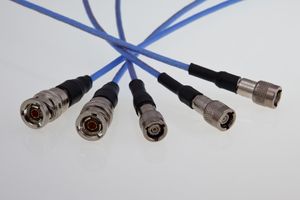Connectors
Connector is an electro-mechanical device for joining electrical circuits as an interface using a mechanical assembly. The connection may be temporary, as for portable equipment, require a tool for assembly and removal, or serve as a permanent electrical joint between two wires or devices.
There are hundreds of types of electrical connectors. Connectors may join two lengths of flexible copper wire or cable, or connect a wire or cable or optical interface to an electrical terminal. In computing, a connector can also be known as a physical interface (compare Physical Layer in OSI model of networking). Cable glands, known as cable connectors in the U.S., connect wires to devices mechanically rather than electrically and are distinct from quick-disconnects performing the latter.
Properties of connectors
Connectors are characterised by their pinout and physical construction, size, contact resistance, insulation between pins, ruggedness and resistance to vibration, resistance to entry of water or other contaminants, resistance to pressure, reliability, lifetime , and ease of connecting and disconnecting.
They may be keyed to prevent insertion in the wrong orientation, connecting the wrong pins to each other, and have locking mechanisms to ensure that they are fully inserted and cannot work loose or fall out. Some connectors are designed such that certain pins make contact before others when inserted, and break first on disconnection; this protects circuits typically in connectors that apply power, e.g. connecting safety ground first, and sequencing connections properly in hot swapping applications.
It is usually desirable for a connector to be easy to identify visually, rapid to assemble, require only simple tooling, and be inexpensive. In some cases an equipment manufacturer might choose a connector specifically because it is not compatible with those from other sources, allowing control of what may be connected. No single connector has all the ideal properties; the proliferation of types is a reflection of differing requirements.
Keying
Many connectors are keyed, with some mechanical component which prevents mating except with a correctly-oriented matching connector. This can be used to prevent incorrect or damaging interconnections, either preventing pins from being damaged by being jammed in at the wrong angle or fitting into imperfectly fitting plugs, or to prevent damaging connections, such as plugging an audio cable into a power outlet. For instance, XLR connectors have a notch to ensure proper orientation, while Mini-DIN plugs have a plastic projection, which fits into a corresponding hole in the socket and prevent different connectors from being pushed together .
Locking mechanisms
Some connector housings are designed with locking mechanisms to prevent inadvertent disconnection or poor environmental sealing. Locking mechanism designs include locking levers of various sorts, screw locking, and toggle or bayonet locking. Depending on application requirements, housings with locking mechanisms may be tested under various environmental simulations that include physical shock and vibration, water spray, dust, etc. to ensure the integrity of the electrical connection and housing seals.
